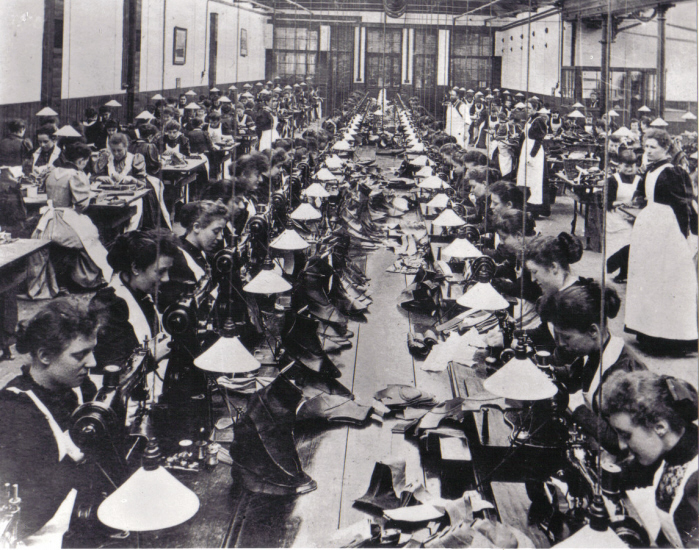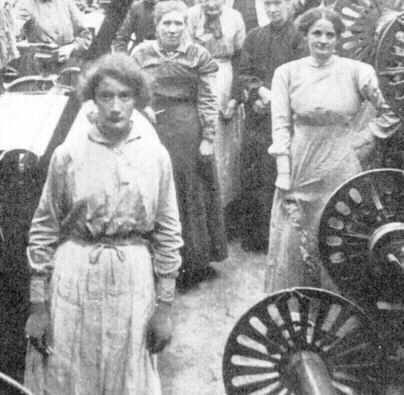
Women in Victorian Britain were divided into four distinct classes: Nobility and Gentry, Middle Class, Upper Working Class, and Lower Working class - each class had its own specific standards and roles. Women were expected to adhere to these standards, and it was considered a high offense to aspire to the standards of another class.
I will focus on the two working classes - as this is where our family would have fallen. The upper working class included any women who were employed in jobs that took skill or thought, as opposed to physical labor. Women of this class often found positions in shops, as bookkeepers, or as teachers. The unique women in this class were the former upper class women, who had fallen into poverty through the death of a father or some other tragedy. A great many of these women became governesses, relaying their own high-class tutoring to upper class children. This position was a deplorable one, as the governess was found a worthy scapegoat in the eyes of everyone, from the master and mistress to the house-maid. A respectable alternative was dressmaking. The clothing industry was dominated by women who either worked in sweatshops, or took in sewing at home, generally making shirts. Seamstresses were quite likely to lose their sight and their pay was between five and ten pence a day.


The lower working class included the desperately poor, typically single women of the Victorian Era. Most women were pronounced "able-bodied" under the New Poor Act and sent to work alongside lower working class men in the factories and other places offering jobs of taxing physical labor. Poor women, like men, were expected to work hard to support themselves. Another popular employment for lower working class women was domestic service (see picture, above left). Even the lowliest middle class family had at least one or two servants, and several had many more than that. Domestic service, though not as physically draining or demoralizing as factory work, had its own hardships (see picture, above right). The life of a domestic servant was very lonely, while factory workers were allowed to socialize as they performed their tasks. Domestic servants worked seven days a week, twelve hours at least each day, while factory workers worked only six days and ten hours per day.
The lowest form of domestic servants were the slaveys, maids hired from 'markets' held under the arches of viaducts where children as young as seven offered themselves for hire. The most unfortunate group of all were those employed to make phosphor matches. They were afflicted with what was called phossy jaw which made them incapable of eating solid food and usually ended in death. There was a huge variety of manufacturing enterprises in which women were involved - matchbox making, sacks, brushes, fans, umbrella bands, even pulling fur from rats, cats and rabbits. In mid century there were about 250,000 servants in London and women were five times more likely to be employed in that capacity as men. About one woman in six made her living in this way at that time.
At the bottom of the social scale, prostitution provided the 'best' living for women. A girl on the streets could earn more in a night than a working man in a week. It was quite possible that she would be healthier too as she would be better fed and better housed. The down side was the danger of disease. The worst of the venereal diseases, syphilis, was incurable until the end of the nineteenth century. Then, as now, a certain number of women lived extremely well but, for the most part, prostitution was apt to end in alcoholism and disease.

Nineteenth-century women were, at least in the minds of most nineteenth-century men, wives and mothers. The difficulty about this concept was that there weren't enough men to go round. The mortality rates for boys were far higher than for girls and men were more likely to emigrate than women. The consequence of the idea that women were essentially wives and mothers was that they were regarded as altogether dependent on men, either as fathers or husbands.
Until 1882, everything that a woman owned passed into the possession of her husband when she married. At the upper end of the social scale, it was possible to arrange marriage settlements, a sort of prenuptial agreement of the time which at least assured a small number of women of some degree of independence. For the vast majority however, even the money they might earn independently belonged to their husbands. It was not until the Married Women's Property Act in 1882 that the position changed.
Nor was there any escape through divorce until 1857. Until then, It was virtually impossible to obtain a divorce because it required a private Act of Parliament which was very expensive. The Matrimonial Causes Act of 1857 might, at first sight, seem an improvement, but in fact it was nothing of the sort. It was now possible, indeed, to obtain a divorce through the courts rather than through Parliament but only men could divorce their partners for adultery. A woman's petition required some extreme provocation such as cruelty, bigamy, incest or desertion. On divorce, the children of the marriage became the property of the husband who could prevent his wife from having any contact with them.
The property rights of women during most of the nineteenth century were dependent upon their marital status. Once women married, their property rights were governed by English common law, which required that the property women took into a marriage, or acquired subsequently, be legally absorbed by their husbands. Furthermore, married women could not make wills or dispose of any property without their husband's consent. Unmarried women maintained control of their property only as long as they remained unmarried.
In English common law, wives could hold no freehold land (real property) except through their husbands; nor could they alter or dispose of property without their husbands' consent, even if it was their own inheritance. This was justified, thusly: The rights of the husband over the property of his wife are given him in consequences of the burthens which on the marriage are imposed on the husband in respect to his wife. In marriage, all the will of the wife was subject to the will of the husband. The rationale was: if husband and wife were one body before God, then they were one person in the law, and that person was represented by the husband.
The Dower Act of 1833 posited that once widowed, women were entitled to a dower, which was usually equivalent to one third of the husband's estate. The dower was the portion of the deceased husband's estate that his widow inherited for her life. Previously, a woman got nothing except what her own husband privately elected to bestow. After 1833, widows were entitled to an equitable jointure of their husband's estate. Jointure assignments were an arrangement by which a husband settled property on his wife for her use after his death. However, the assignment of jointures deprived widows of legal rights over their husband's estates and allowed the valuable real property, which was land, to be left to male heirs.
In 1855, a woman's status could be described thusly:
- A married woman had no legal existence whether or not she was living with her husband;
- A woman's property was his property;
- A woman could not make a will, the law gives what she has to her husband despite her wishes or his behavior;
- A woman could not keep her earnings;
- A man could sue for restitution of conjugal rights and thus force her to return to his home;
- A woman was not allowed to defend herself in divorce;
- A woman could not divorce her husband since the House of Lords in effect would not grant a divorce to her;
- A woman could not sign a lease or transact business;
- A woman could not claim support from her husband; his only obligation was to make sure she didn't land in the parish poorhouse if he had means; and,
- a woman could not bind her husband to any agreement.
- In sum, the husband had the right to all that was hers; the wife had no right to anything that was his.
Sources
Various websites, including:
Property rights of Women in Nineteenth-Century England http://www.umd.umich.edu/casl/hum/eng/classes/434/geweb/PROPERTY.htm
Women of Victorian England: http://crayzray.tripod.com/clpage/writtings/other/victorian_women.htm
Women, Wives and Widows http://www.st-andrews.ac.uk/~city19c/viccity/women.html